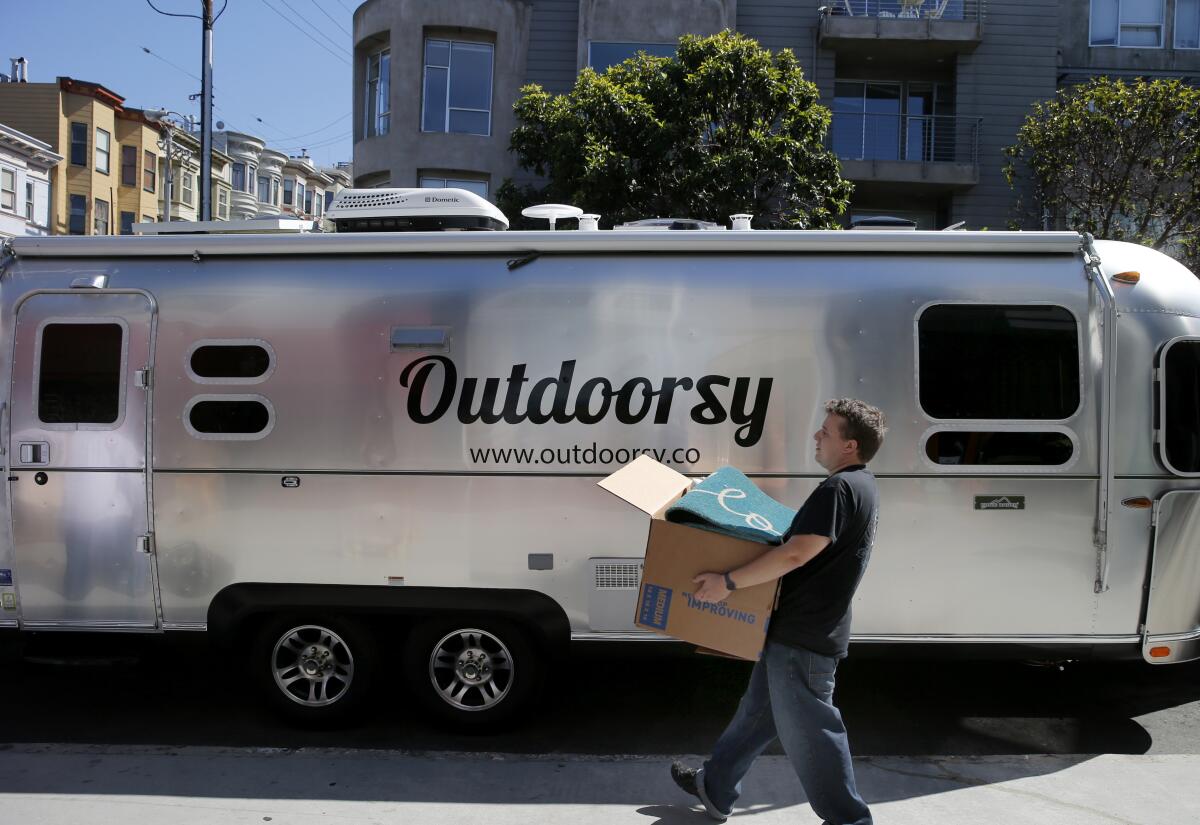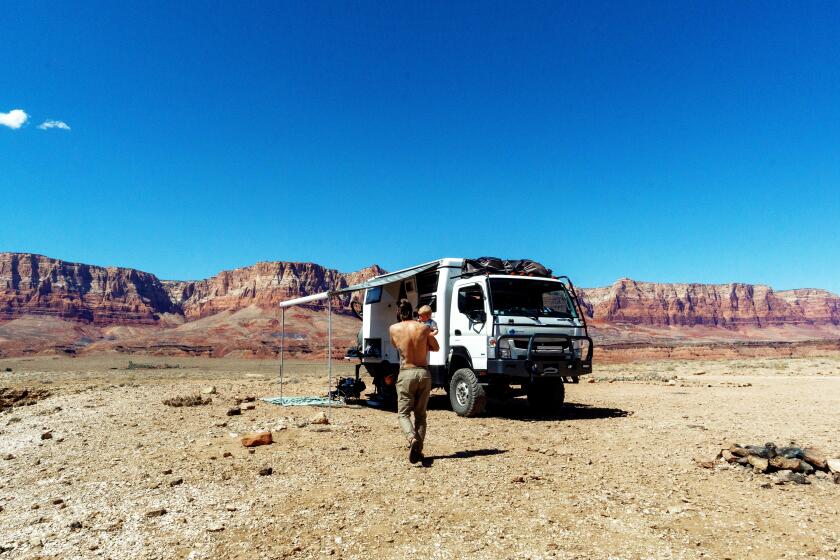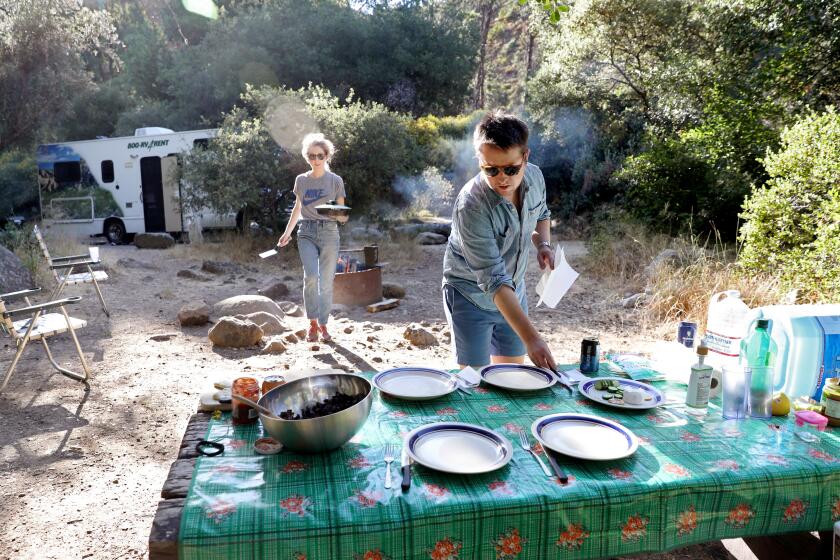Love RV travel but hate driving one? RV delivery is growing

San Diego mom of two Audrey Patterson frequently vacations in a recreational vehicle with her family. But she’s actually driven an RV only once — a brief stretch on Los Angeles’ tangled web of freeways — en route to Yosemite National Park for their 2021 summer vacation.
“I was super overwhelmed, and I just felt bad for everyone,” Patterson said.
Patterson’s husband usually drives. When it came time for the family’s summer 2022 vacation — a camping trip to Big Sur — her husband couldn’t drive because he was arriving a day later.
With the L.A. driving memory fresh on her mind, coupled with the fact that she would be solo parenting her 2- and 4-year-old boys, Patterson was intent on not getting behind the wheel of an RV to Big Sur.
“My husband suggested researching if we could get an RV delivered, and I was like, ‘Oh, my gosh, yes,’” she said.
RV delivery is one of the latest trends in camping, upending the traditional model in which you exchange your car for an RV at a rental facility.
One of the biggest RV delivery operators is RVshare, a company that operates like Airbnb for RVs. And although not all RVs offered there are deliverable, RVshare said that almost 40% of its RV rentals have been delivered in 2022, up from 27% in 2021 and 16% in 2020.
Eager to escape claustrophobic pandemic life and take advantage of newly remote jobs, increasing numbers of Americans are taking to remote places in rugged vehicles that are also homes.
With RV delivery, you don’t have to worry about driving, fuel economy and liability. Instead, you simply arrive at a campground to an RV that’s already set up for you. Patterson rented through a similar service called Outdoorsy, which says 70% of its listings offer delivery.
Other delivery companies own and operate the RVs themselves. Most are regional, such as Southern California’s 101 RV Rentals, which delivers to campgrounds in Santa Barbara County.
Who are RV deliveries for?
RV deliveries can be great for nature lovers, but that’s not the only clientele. It’s also handy for those traveling to a destination with no hotels available or a place where hotels are expensive.
RVshare said its top 2021 delivery destination was the campsites at Disney’s Fort Wilderness Resort, located a quick ferry ride from the Magic Kingdom theme park in Florida — and it’s getting more popular. According to RVshare, RV deliveries at Fort Wilderness for the first three quarters of 2022 were up 12% compared with the same period in 2021.
The cost of a campsite at Fort Wilderness, including full RV hookups, is $1,300 for a six-night stay during the first week of March 2023. For a six-person cabin at the resort itself over the same period, you’d pay $3,600.
Sure, the cost of the RV rental and delivery eats into the $2,300 difference. But across delivery sites such as RVshare and Outdoorsy, there are dozens of available listings large enough to sleep six that cost less than $1,000 for the week, including delivery and setup. A few are even less than $500, making an RV rental one of the cheapest ways to sleep at Disney World.
The COVID-19 pandemic has created a red-hot market for RVs and camping gear. This demand can provide a way to make some money when jobs are scarce.
Limitations of RV delivery
Some campgrounds ban delivery: Rules vary by campground and across state and national parks. For example, RV delivery is prohibited in Yellowstone National Park, but it’s OK for some sites at Yosemite National Park.
Patterson said she prefers delivery if she’s driving to the campground in one day with minimal stops. But for a leisurely trip with many stops, she might default to driving the RV, especially because it gives her kids room to spread out.
Delivery fees can be confusing: Outdoorsy lets owners set delivery fees, which means that sometimes an RV with cheaper rent might turn out to be more expensive if delivery fees are high. Some companies charge a flat rate for delivery (typically $150 to $300), while others charge by distance (typically $4 to $6 per mile). And most limit deliveries to a certain area.
You can’t pack as much: For rentals near home, you can pack the RV from your own driveway. Otherwise, you’ll be equipped only with what you can fit in the vehicle that gets you to the campground. That especially can limit bulky items — such as bikes and surfboards.
Benefits of RV delivery
RVs can be one of the most desirable ways to camp, offering conveniences such as air conditioning, kitchens, power outlets and Wi-Fi. Many of their challenges can be mitigated by delivery.
You save on gas by driving a car — not an RV — to the destination: Cruise America says, on average, its RVs get 6 to 10 mpg. Instead, you drive your car — which should get better fuel economy — on the road trip and have an RV delivered from a place closer to your destination.
With the coronavirus crisis roiling vacation plans, some are turning to travel that allows for social distancing, including RV camping. This reporter tried it.
Insurance is often cheaper for deliveries: Outdoorsy requires that all renters have an insurance package that covers liability and damage. For deliveries, that insurance is cheaper because you’re not paying to cover the rig on the road. Sometimes it’s less than a quarter of the cost of Outdoorsy’s comprehensive coverage to insure an RV that you’ll drive.
No onerous setup: RVs can be challenging (particularly for first-timers) to hook up, which is necessary to access fresh water, sewers and electricity.
Since Patterson has no room to store an RV if she had one, she rents every time. But each type of RV does have its downsides. With a van, she has to remove hookups and secure the items inside every time her family drives off the campsite. A detachable trailer RV provides more freedom.
“But maneuvering detachable trailers on winding roads is tough,” she says. “With RV delivery, it’s almost all upside.”
French writes for personal finance website NerdWallet. This article was distributed by the Associated Press.
More to Read
Inside the business of entertainment
The Wide Shot brings you news, analysis and insights on everything from streaming wars to production — and what it all means for the future.
You may occasionally receive promotional content from the Los Angeles Times.












